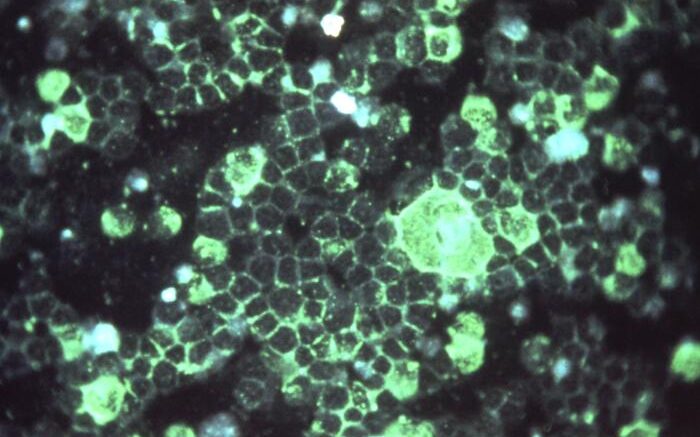Using indirect immunofluorescence microscopy, this photomicrograph revealed the presence of the respiratory syncytial virus (RSV) in an unidentified tissue sample, RSV is the most common cause of bronchiolitis and pneumonia among infants and children under 1 year of age. Courtesy of CDC/Dr. Craig Lyerla
The widespread non-pharmaceutical interventions implemented to mitigate the transmission of COVID-19 have led to drastic reductions in the annual circulation patterns of other endemic respiratory viruses, including influenza and the common cold. How this will affect future transmission patterns of these pathogens remains unknown.
In a Perspective, Gabriela Gomez and colleagues discuss what could be expected concerning the epidemiology of common respiratory viruses once the COVID-19 pandemic subsides and argue that expanded genomic and clinical surveillance is needed to best understand the spread of respiratory viruses in a post-COVID-19 world.
"Currently, the emergency response to COVID-19 is a global priority, but preparation for future threats by building on existent global networks, fostering synergies and expanding collaborations among a more inclusive stakeholder population should not be overlooked," write the authors.
While non-pharmaceutical interventions (NPIs) like facemask use, increased handwashing practices, social distancing and restrictions on global travel have been instrumental in reducing the spread of COVID-19, they have also had a great impact on the circulation of seasonal respiratory viruses. However, as these general restrictions and mandates have eased worldwide, countries have begun to report increases in off-season infections of some viruses, such as respiratory syncytial virus and rhinovirus. Similar trends in resurgence have not been observed for other illnesses like influenza, however.
According to the authors, these emergent patterns could reflect unforeseen changes in population-level immunity or virus epidemiology, both of which could increase the chances of pandemic flu or limit viral evolution and make vaccination more effective, among other outcomes. The uncertainty in future scenarios for endemic respiratory viruses after COVID-19 raises the need for an improved and comprehensive approach to respiratory disease and viral genomic surveillance.
Source: American Association for the Advancement of Science

Be the first to comment on "Surveillance for Endemic Respiratory Viruses Needed to Understand Post-COVID-19 Circulation"